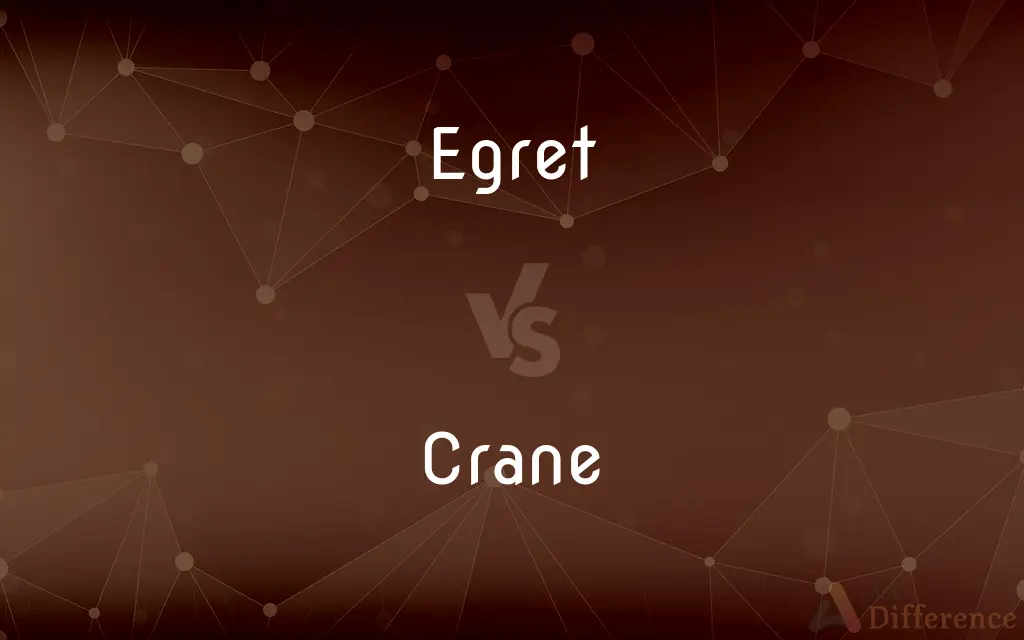Egret vs. Crane — What's the Difference?
Edited by Tayyaba Rehman — By Fiza Rafique — Updated on November 3, 2023
Egrets are white herons with long legs and necks, often with ornate plumes; cranes are larger birds with a more varied coloration and a harsher call.

Difference Between Egret and Crane
Table of Contents
ADVERTISEMENT
Key Differences
Egrets are part of the heron family, typically known for their all-white plumage and are often found near water bodies, marshes, and wetlands. Cranes, although similar in appearance with their long legs and necks, are a distinct family and are more diverse in habitat, often found in both wetlands and dry plains.
In terms of behavior, egrets can be seen hunting alone or in small groups, moving slowly in shallow water to catch their prey. Cranes are more sociable birds, often found in large flocks and known for their elaborate dancing rituals during mating season, which are not characteristic of egrets.
Plumage is a notable difference, with egrets having delicate, ornamental feathers especially during the breeding season, used historically in the fashion industry. Cranes, on the other hand, have more varied plumage colors and patterns, with some species like the Grey Crowned Crane, exhibiting striking feather arrangements.
The flight patterns of egrets and cranes also differ; egrets fly with a steady, deliberate beat of their rounded wings, often with their neck retracted, giving them a hunched appearance. Cranes fly with a straight neck, powerful wingbeats, and can travel long distances during migration, which is much rarer for egrets.
Lastly, egrets are generally smaller and lighter than cranes, which can stand up to more than 5 feet tall and are often considered symbols of longevity and fidelity in many cultures due to their long lifespans and monogamous nature.
ADVERTISEMENT
Comparison Chart
Family
Ardeidae (Heron family)
Gruidae
Size
Generally smaller
Larger and taller
Social Behavior
Often solitary or in small groups
Sociable, living in large flocks
Flight
Neck retracted, slow wingbeats
Neck extended, strong wingbeats
Mating Display
Less elaborate courtship
Elaborate dancing rituals
Compare with Definitions
Egret
A usually white bird of the heron family with long legs and neck.
An egret waded carefully through the marsh in search of fish.
Crane
A tall wading bird with a long neck, bill, and legs, known for its migratory behavior.
The crane stretched its long legs as it stepped through the shallow water.
Egret
A bird species recognized by its plumed head and delicate ornamental feathers.
The egret stood out against the green backdrop with its pristine white feathers.
Crane
A bird distinguished by its loud call and diverse coloration among species.
We could hear the distinctive call of cranes in the distance.
Egret
A wading bird, often found in wetlands, known for its elegant appearance.
Photographers gathered to capture the annual nesting of the egrets.
Crane
A large bird often associated with symbolic meanings in various cultures.
The crane is revered in many Asian cultures as a symbol of happiness and eternal youth.
Egret
A member of the genus Ardea, closely related to herons and bitterns.
Egrets and herons often occupy the same wetland habitat.
Crane
A species known for complex mating dances and social behavior.
The pair of cranes engaged in an intricate dance that fascinated the onlookers.
Egret
Egrets are herons that have white or buff plumage, developing fine plumes (usually milky white) during the breeding season. Egrets are not a biologically distinct group from herons and have the same build.
Crane
A member of the family Gruidae, separate from herons and storks.
Cranes are often mistaken for storks, but the two belong to different families.
Egret
Any of several usually white herons of the genera Ardea, Bubulcus, and Egretta, characteristically having long, showy plumes during the breeding season.
Crane
Any of various large wading birds of the family Gruidae, having a long neck, long legs, and a long bill.
Egret
Any of various wading birds of the genera Egretta or Ardea that includes herons, many of which are white or buff, and several of which develop fine plumes during the breeding season.
Crane
A similar bird, such as a heron.
Egret
A plume or tuft of feathers worn as a part of a headdress, or anything imitating such an ornament.
Crane
A machine for hoisting and moving heavy objects by means of cables attached to a movable boom.
Egret
(botany) The flying feathery or hairy crown of seeds or achenes, such as the down of the thistle.
Crane
Any of various devices with a swinging arm, as in a fireplace for suspending a pot.
Egret
(obsolete) The crab-eating macaque (Macaca fascicularis)
Crane
To hoist or move with or as if with a crane.
Egret
The name of several species of herons which bear plumes on the back. They are generally white. Among the best known species are the American egret (Ardea egretta syn. Herodias egretta); the great egret (Ardea alba); the little egret (Ardea garzetta), of Europe; and the American snowy egret (Ardea candidissima).
A bunch of egrets killed for their plumage.
Crane
To strain and stretch (the neck, for example) in order to see better.
Egret
A plume or tuft of feathers worn as a part of a headdress, or anything imitating such an ornament; an aigrette.
Crane
To stretch one's neck toward something for a better view.
Egret
The flying feathery or hairy crown of seeds or achenes, as the down of the thistle.
Crane
To be irresolute; hesitate.
Egret
A kind of ape.
Crane
Any bird of the family Gruidae, large birds with long legs and a long neck which is extended during flight.
Egret
Any of various usually white herons having long plumes during breeding season
Crane
Ardea herodias, the great blue heron.
Egret
Aquatic bird with a slender build and typically seen in warm regions.
We spotted several egrets during our canoe trip down the river.
Crane
A mechanical lifting machine or device, often used for lifting heavy loads for industrial or construction purposes.
Crane
An iron arm with horizontal motion, attached to the side or back of a fireplace for supporting kettles etc. over the fire.
Crane
A siphon, or bent pipe, for drawing liquors out of a cask.
Crane
(nautical) A forked post or projecting bracket to support spars, etc.; generally used in pairs.
Crane
(obsolete) The cranium.
Crane
(ambitransitive) To extend (one's neck).
Crane
(transitive) To raise or lower with, or as if with, a crane.
Crane
(intransitive) To pull up before a jump.
Crane
A wading bird of the genus Grus, and allied genera, of various species, having a long, straight bill, and long legs and neck.
Crane
Any arm which swings about a vertical axis at one end, used for supporting a suspended weight.
Crane
A machine for raising and lowering heavy weights, and, while holding them suspended, transporting them through a limited lateral distance. In one form it consists of a projecting arm or jib of timber or iron, a rotating post or base, and the necessary tackle, windlass, etc.; - so called from a fancied similarity between its arm and the neck of a crane See Illust. of Derrick.
Crane
An iron arm with horizontal motion, attached to the side or back of a fireplace, for supporting kettles, etc., over a fire.
Crane
A siphon, or bent pipe, for drawing liquors out of a cask.
Crane
A forked post or projecting bracket to support spars, etc., - generally used in pairs. See Crotch, 2.
Crane
The American blue heron (Ardea herodias).
Crane
To cause to rise; to raise or lift, as by a crane; - with up.
What engines, what instruments are used in craning up a soul, sunk below the center, to the highest heavens.
An upstart craned up to the height he has.
Crane
To stretch, as a crane stretches its neck; as, to crane the neck disdainfully.
Crane
To reach forward with head and neck, in order to see better; as, a hunter cranes forward before taking a leap.
The passengers eagerly craning forward over the bulwarks.
Crane
United States writer (1871-1900)
Crane
United States poet (1899-1932)
Crane
Lifts and moves heavy objects; lifting tackle is suspended from a pivoted boom that rotates around a vertical axis
Crane
Large long-necked wading bird of marshes and plains in many parts of the world
Crane
Stretch (the neck) so as to see better;
The women craned their necks to see the President drive by
Common Curiosities
What distinguishes an egret from other herons?
Egrets are mainly distinguished by their white color and sometimes by their plumes during the breeding season.
What is the significance of cranes in culture?
Cranes are often seen as symbols of longevity, peace, and fidelity.
Are egrets protective of their nesting sites?
Yes, egrets can be quite protective of their nesting sites during the breeding season.
What do cranes eat?
Cranes have a varied diet that includes plants, seeds, insects, and small animals.
Do egrets mate for life like cranes?
Egrets do not typically mate for life, which is a behavior more common in cranes.
Do egrets migrate?
Some egret species migrate, but many are resident or partially migratory depending on their location.
Can cranes be found worldwide?
Cranes are found on all continents except South America and Antarctica.
Are cranes endangered?
Some crane species are endangered due to habitat loss and other environmental pressures.
How do egrets hunt for food?
Egrets hunt by standing still or walking slowly in shallow water to spear fish and amphibians with their sharp bills.
How do egrets interact with other birds?
Egrets can be solitary but sometimes nest in colonies with other heron species.
What is a group of cranes called?
A group of cranes is often referred to as a "sedge" or "siege."
Can egrets and cranes be found in the same habitats?
While both can be found in wetlands, their specific habitat preferences and range may differ.
How can I identify a crane in the wild?
Look for a tall bird with a long neck and legs, often with a loud call and, in some species, a crest of feathers.
Are egrets affected by environmental changes?
Yes, egrets are sensitive to environmental changes, especially those affecting wetlands.
Why do cranes dance?
Cranes perform dances for courtship, to strengthen bonds, and sometimes as a form of aggression display.
Share Your Discovery

Previous Comparison
Many vs. Multiple
Next Comparison
Jester vs. MimeAuthor Spotlight
Written by
Fiza RafiqueFiza Rafique is a skilled content writer at AskDifference.com, where she meticulously refines and enhances written pieces. Drawing from her vast editorial expertise, Fiza ensures clarity, accuracy, and precision in every article. Passionate about language, she continually seeks to elevate the quality of content for readers worldwide.
Edited by
Tayyaba RehmanTayyaba Rehman is a distinguished writer, currently serving as a primary contributor to askdifference.com. As a researcher in semantics and etymology, Tayyaba's passion for the complexity of languages and their distinctions has found a perfect home on the platform. Tayyaba delves into the intricacies of language, distinguishing between commonly confused words and phrases, thereby providing clarity for readers worldwide.














































